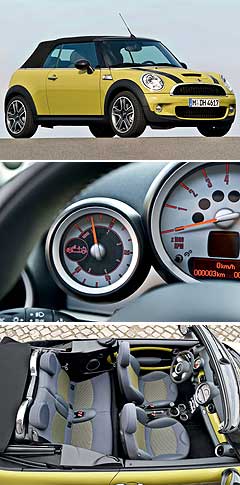Make / Model Search
Future models - Mini - ConvertibleFirst look: New Mini drop-top is right on cueNot before time: BMW's MkII Mini Cabrio arrives around mid-2009. No surprises with Mini's MkII Cabrio as BMW opens up its second-generation Cooper28 Nov 2008 IT was only a matter of time before the convertible version of BMW’s second-generation Mini Cooper hatch emerged. After all, the new R56-series hard-top has been selling up a storm here since March 2007 and so far this year has found more than 1500 Australian homes, while the original R52 Mini soft-top has soldiered on to win just 269 Aussie hearts in 2008 – well down on its 675 peak in 2005, when it was among the nation's most popular ‘sports cars’. Now that it has, less than four years after BMW’s first Mini Cabrio arrived here (in January 2005, three whole years after the original Mini hatch) and just in time for summer – although the newest topless Mini won’t go on sale globally until the second quarter of 2009 – the only question remains ‘why did it take so long?’. As these first images of the all-new R57-series Mini Cooper S Cabrio show, the redesigned four-seater cabriolet takes the hard-top’s discreetly different but all-new and slightly larger bodyshell, then adds its own new soft-top with integrated sliding roof function, which folds back automatically in 15 seconds at speeds of up to 30km/h.  Thanks to a modest increase in overall body length, the new Mini Cabrio is more accommodating than before in most key dimensions, including its boot capacity with the roof open, which at just 125 litres is five litres bigger than before but still falls 80 litres short of BMW’s larger and more expensive (rear-drive) 1 Series Convertible. Thanks to a modest increase in overall body length, the new Mini Cabrio is more accommodating than before in most key dimensions, including its boot capacity with the roof open, which at just 125 litres is five litres bigger than before but still falls 80 litres short of BMW’s larger and more expensive (rear-drive) 1 Series Convertible.Cargo room with the roof closed also increases by five litres to 170 litres, while luggage space with the rear seats folded down liberates 660 litres – 55 more than the current Mini Cabrio. BMW says the new cabrio’s uniquely large through-loading aperture behind the pair of individually-folding rear seatbacks, ingeniously dubbed the Easy-Load Function, is made possible by the full-width single-piece rollover bar that, when required, deploys upwards from behind the rear head restraints in 150 milliseconds. The new pop-up rollbar replaces the current cabrio’s unsightly twin fixed hoops. Other new features include an optional automatic climate-control air-conditioning system with ‘cabrio mode’ and “seamless integration of external music players” via a USB port and Apple iPhone-compatible Bluetooth hands-free phone system. Naturally, there are 12 “highly attractive” exterior paint colours, but the new Mini Cabrio’s biggest party trick appears to be the “absolutely unique” new optional Always-Open Timer gauge, which resides next to the tacho and shows occupants how long they’ve driven with the roof down. BMW says it is aimed at “motivating the driver to really enjoy the thrill of open-air motoring as frequently as possible”, but we suspect it will be more useful in avoiding sunburn. Of course, the open-top Mini, which was joined in March this year by the five-door Clubman wagon, comes with the same punchy new PSA 1.6-litre four-cylinder Valvetronic petrol engines that were co-developed with PSA Peugeot Citroen and debuted in the new Mini hatch last year, reducing fuel consumption and C02 emissions by a claimed 19 per cent over the engines they replace. That means the entry-level Cooper Cabrio delivers an identical 88kW at 6000rpm and 160Nm of torque at 4250rpm – resulting in claimed 0-100km/h acceleration in 9.8 seconds and a 198km/h top speed. Fuel consumption is just 6.1L/100km and CO2 emissions are rated at 145g/km. Powering the new Cooper S Cabrio is the Cooper S hatch’s twin-scroll turbocharged and direct-injected version of the same engine, producing an identical 128kW at 5500rpm and 240Nm between 1600 and 5000rpm – 260Nm in ‘overboost’ mode. Similarly, BMW says, at 7.2L/100km and 171g/km. Top speed is 222km/h, with 0-100km/h acceleration stated at a more respectable 7.4 seconds. As it did in the R56 Cooper S hard-top, the turbo four replaces the 125kW/220Nm supercharged four in the outgoing R50 Cooper S Cabrio, but the drop-top’s six-speed manual and automatic transmissions carryover. Expect go-faster John Cooper Works versions to up the Mini Cabrio ante further still, to the same 155kW and 260Nm outputs as the recently-released JCW hatch, while the 80kW/240Nm 1.6-litre turbo-diesel Mini D is also due for Australian launch in 2009. BMW's original R52-series Mini Cabrio ceased production at the Oxford plant in the UK in early August to make way for the all-new model. Read more:Mini closes Cabrio’s doorsFirst drive: Mini slams down premium Coopers All future modelsConvertible pricing
Motor industry news |
Click to shareMini modelsResearch Mini All future modelsConvertible pricing
Motor industry news |

 Alfa Romeo
Alfa Romeo Abarth
Abarth Audi
Audi Aston Martin
Aston Martin BMW
BMW Bentley
Bentley Ferrari
Ferrari Chevrolet
Chevrolet Ford
Ford Fiat
Fiat GWM
GWM Foton
Foton Hyundai
Hyundai Honda
Honda Jaguar
Jaguar Isuzu
Isuzu Kia
Kia Jeep
Jeep Land Rover
Land Rover Lamborghini
Lamborghini Maserati
Maserati Lexus
Lexus McLaren
McLaren Mazda
Mazda Mercedes-Benz
Mercedes-Benz Mitsubishi
Mitsubishi Mini
Mini Peugeot
Peugeot Nissan
Nissan Ram
Ram Porsche
Porsche Rolls-Royce
Rolls-Royce Smart
Smart Skoda
Skoda Suzuki
Suzuki Subaru
Subaru Toyota
Toyota Tesla
Tesla Volvo
Volvo Zeekr
Zeekr







Facebook Twitter Instagram